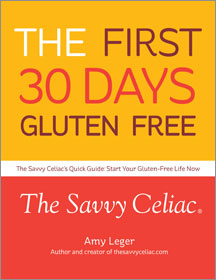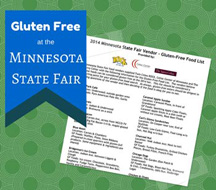You know what I’m talking about; in your own kitchen. This post hopefully will help celiacs, those who prepare food for them, and anyone else, in their own kitchen to think about just how clean certain items in their kitchen really are. I may have clutter in my house, but I am extremely careful about my dishes, cleanliness and cross contamination.
Are we really worried about kitchen hygiene?
Polls say yes, but research says no. According to a report out in the last month from DataMonitor, “Research suggests that the vast majority of people [DataMonitor spoke to] are aware of the importance of good hygiene practices, but this knowledge is yet to be applied to the same extent.”
In fact last summer Reuters (and many other organizations) reported on an international study which showed “…nearly half of all kitchen sinks harbor high levels of potentially dangerous bacteria.” Keeping in mind that this study was sponsored by Lysol brand products, this statistic does seem kind of gross. Incidentally – kitchen cloths and sponges are the worst at harboring bacteria! Quick hint: Zap your sponge in the microwave. WebMD reported on a 2007 study recommending the microwaving of sponges for 2 minutes to get out 99% percent of germs and bacteria.
My point is, if our kitchens aren’t clean from dangerous bacteria like salmonella – then what are the chances we could unknowingly be cross-contaminating our gluten-free food with dishes that just might not be getting clean enough? (Clearly this doesn’t count if you live in a gluten-free environment.)
Gluten Germs
Would you say kitchen hygiene is a relative term? What is clean to me may not be clean to you. I have in the past reminded people that wiping a knife of gluten, doesn’t mean it’s “celiac clean”. What about plastic or wooden cutting boards with those deep grooves. How do they ever get clean? Let alone “celiac clean”?
So here is the golden rule of “celiac clean” and staying clear of cross contamination: Separate, separate separate! In other words get separate items for gluten-free cooking and make sure everyone who uses your kitchen knows which items are for gluten, and which are not!
So what items should you get duplicates of??
…cutting boards for gluten and gluten-free items
…colanders for the different pasta (have you ever really looked at the residue that can get wedged in the holes even after being in the dishwasher?)
…knives – if they go into a block. Some households use their bread knife, for example, and then put it back into the block – contaminating the block for good.
…wooden spatulas, spoons. Porous materials just don’t get clean enough to use in both gluten-free and non-gluten-free foods.
…stoneware for baking, i.e. Pampered Chef and others like it, for the same reason as above, porous. The stoneware likely can’t get clean enough to use for both gluten and non-gluten baking. According to the Pampered Chef’s stoneware care instructions: “Hand wash in hot water…It is not recommended to use soap, detergent or an automatic dishwasher. Remove excess food with scraper.” If Pampered Chef is your favorite, then get a second gluten-free set, I’m sure the company will love you for it.
Can you think of any others? Feel free to add to the comment section of the blog! There are many other things to separate in your kitchen, but it’s not related to hygiene and cleanliness, but rather simply cross contamination: toasters, butter, peanut butter, etc. But that is another post all by itself.
Feeling like your kitchen isn’t quite clean enough now? Me too, I’m off to clean and “zap” my sink sponge!
Tags: celiac, clean, gluten-free, hygiene, kitchen cookware



February 9th, 2009 at 3:19 pm
The problem with this analysis is that gluten is a contaminant, not an infectious agent. You’re conflating hygeine with simple cleaning, when the two really have little to do with each other. You could have a downright filthy kitchen from an infectious agent perspective, and still be completely gluten-free. Bacteria are living organisms–if you leave even a few on a surface when you clean, they will multiply until you’re back to the same population you had before you cleaned. Gluten doesn’t grow, it doesn’t multiply, it is completely immobile in and of itself, and it can easily be washed off of any reasonably non-porous surface. It _can’t_ be disinfected, so spraying on more bleach or soap is pointless. Just get cutting boards that can be put in the dishwasher, wash the colander with soap & water and rinse well, wash that bread knife (really not hard to remember) and all the others as well, etc.
The pores in many of the hard-but-porous kitchen items (e.g., ceramics, teflon coatings) are too small to catch & hold the rather large gluten protein molecules. Furthermore, the protein is part of whatever food it’s in, and those particles are really too large to be trapped in the pores.
I agree the toaster is a problem, because it is a crumb trap. My solution–a cheap ($15 or less store brand at Target) 4 slice toaster with one side marked GF in permanent magic marker, cleaned regularly. No problems yet–in over 4 years of using it. Because it was cheap I don’t care if I have to replace it when it gets too nasty even with regular cleaning.
I think crumb contamination in communal foods (the ever-present peanut butter, mayonnaise, butter) is the really big issue. It’s much more important either to insist on separate containers of these foods, or to train everyone not to double-dip. The old etiquette rule of using the master butter knife to put butter on your plate, and your own knife for spreading, strikes me as one to reinstate. Teach your kids early, and they’ll remember it. Teach your spouse, friends, family, etc. that when they’re in your house, they follow your rules. There are no kids in my house, but I’ve had no problem training any adults who come into my kitchen that this is necessary for my health. They don’t have to understand it, or even believe that your gf diet is necessary, just know that if they don’t follow your rules, they won’t be welcome.